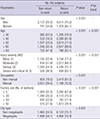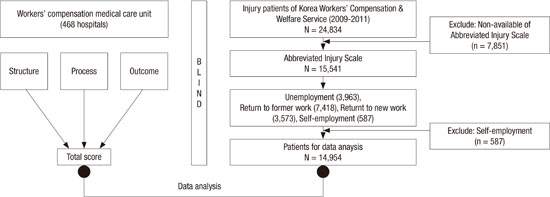1. Dembe AE. The social consequences of occupational injuries and illnesses. Am J Ind Med. 2001; 40:403–417.
2. He Y, Hu J, Yu IT, Gu W, Liang Y. Determinants of return to work after occupational injury. J Occup Rehabil. 2010; 20:378–386.
3. Park SK. Associations of demographic and injury-related factors with return to work among job-injured workers with disabilities in South Korea. J Rehabil Med. 2012; 44:473–476.
4. Rhie J, Jeong I, Won JU. Return-to-work according to impairment type among occupationally injured workers in Korea. J Korean Med Sci. 2013; 28:1581–1586.
5. Franche RL, Baril R, Shaw W, Nicholas M, Loisel P. Workplace-based return-to-work interventions: optimizing the role of stakeholders in implementation and research. J Occup Rehabil. 2005; 15:525–542.
6. Franche RL, Krause N. Readiness for return to work following injury or illness: conceptualizing the interpersonal impact of health care, workplace, and insurance factors. J Occup Rehabil. 2002; 12:233–256.
7. Franche RL, Cullen K, Clarke J, Irvin E, Sinclair S, Frank J. Institute for Work & Health (IWH) Workplace-Based RTW Intervention Literature Review Research Team. Workplace-based return-to-work interventions: a systematic review of the quantitative literature. J Occup Rehabil. 2005; 15:607–631.
8. Shaw WS, Pransky G, Fitzgerald TE. Early prognosis for low back disability: intervention strategies for health care providers. Disabil Rehabil. 2001; 23:815–828.
9. Himmelstein JS, Pransky G. Measuring and Improving the Quality of Workers' Compensation Medical Care. Princeton, NJ: John Burton's Workers' Compensation Monitor;1995. p. 4–9.
10. Won J. Investigation to Develop the Assessment Tool for Workers' Compensation Medical Care System Focus on Rehabiltation, and Its Quantity Score of Hospital. Seoul: Korea Workers' Compensation and Welfare Service;2012.
11. Thompson ML, Myers JE, Kriebel D. Prevalence odds ratio or prevalence ratio in the analysis of cross sectional data: what is to be done? Occup Environ Med. 1998; 55:272–277.
12. Berecki-Gisolf J, Clay FJ, Collie A, McClure RJ. The impact of aging on work disability and return to work: insights from workers’ compensation claim records. J Occup Environ Med. 2012; 54:318–327.
13. Stoddard S, Jans L, Ripple JM, Kraus L. Chartbook on Work and Disability in the United States, 1998. Washington, D.C.: National Institute on Disability and Rehabilitation Research;1998.
14. Pransky G, Shaw W, Franche RL, Clarke A. Disability prevention and communication among workers, physicians, employers, and insurers--current models and opportunities for improvement. Disabil Rehabil. 2004; 26:625–634.
15. Shaw WS, Feuerstein M, Lincoln AE, Miller VI, Wood PM. Case management services for work related upper extremity disorders. Integrating workplace accommodation and problem solving. AAOHN J. 2001; 49:378–389.
16. Kunkel S, Rosenqvist U, Westerling R. The structure of quality systems is important to the process and outcome, an empirical study of 386 hospital departments in Sweden. BMC Health Serv Res. 2007; 7:104.
18. Shaw W, Hong QN, Pransky G, Loisel P. A literature review describing the role of return-to-work coordinators in trial programs and interventions designed to prevent workplace disability. J Occup Rehabil. 2008; 18:2–15.
19. Won J, Ahn Y, Song J, Koh D, Roh J. Occupational injuries in Korea: a comparison of blue-collar and white-collar workers’ rates and underreporting. J Occup Health. 2007; 49:53–60.







 PDF
PDF ePub
ePub Citation
Citation Print
Print







 XML Download
XML Download